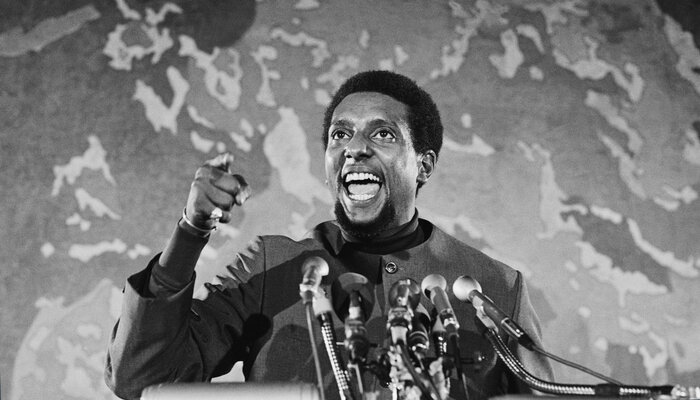In February 2023, the Brennan Center hosted a talk in New York with journalist and author Mark Whitaker and Pulitzer Prize–winning columnist Eugene Robinson. Whitaker discussed his book, excerpted below, Saying It Loud: 1966—The Year Black Power Challenged the Civil Rights Movement. You can watch the full conversation here.
In the middle of Alabama, U.S. Route 80, the highway that links Selma and Montgomery, narrows to two lanes as it passes through Lowndes County, deep in the former cotton plantation territory known as the Black Belt. For decades, the deadly reach of the Ku Klux Klan made this slender stretch of open road, surrounded by swamps and spindly trees covered with Spanish moss, one of the scariest in the South. During the historic civil rights march between those two cities in 1965, fewer than three hundred protesters braved the Lowndes County leg, whispering as they hurried through a rainstorm about rumors of bombs and snipers lurking out of sight. When the march ended, cars transporting demonstrators back to Selma drove as fast as they could through Lowndes County, without stopping.
One car didn’t make it. Viola Liuzzo was a thirty-nine-year-old mother of five from Detroit who had answered the Reverend Martin Luther King Jr.’s call for whites to join the Selma march. After it was over, she was helping drive marchers back from Montgomery along with a young Black volunteer named Leroy Moton. As the two headed back to Montgomery after a drop-off in Selma shortly after nightfall, a red-and-white Chevrolet Impala pulled alongside Liuzzo’s blue Oldsmobile on Route 80. A spray of bullets exploded into the driver’s side window, and the car careened off the road and into a ditch. Moton passed out, and when he came to Liuzzo was slumped lifeless on the bench front seat, her foot still on the accelerator.
Moton raced through the darkness to report the attack—which, it would soon emerge, was carried out by four Alabama Klansmen, one of them a paid informant for the FBI.
Two days later, as newspapers across the country ran front-page updates on the murder of the first white woman to die in the civil rights struggle, five young Black organizers from the Student Nonviolent Coordinating Committee slipped unnoticed into Lowndes County on Route 80. The five were there to bring SNCC’s mission of voter registration to the county, an impoverished backwater with the largest percentage of Black residents in the state, but where not a single Black had cast a ballot in more than sixty years. The group’s leader was Stokely Carmichael, a lanky New Yorker with a long, angular nose and heavy-lidded but expressive eyes. His voice mixed the lilt of Trinidad, where he lived until age eleven; the urgency of the Bronx, where he spent his teens; and the polish of Howard University, the distinguished historically Black college from which Carmichael graduated. Over the next eight months, SNCC organizers proved successful enough that white farmers punished Black sharecroppers who registered to vote by evicting them from their land. So it was that, as the year 1965 ended, Carmichael and his comrades found themselves back along Route 80, erecting tents for displaced families while sharecroppers armed with hunting rifles kept watch for night-riding Klansmen.
On the second to last day of December, Carmichael was putting up tents on a six-acre plot that a local church group had purchased by the side of Route 80 when a blue Volkswagen Beetle drove up. A thin, mocha-skinned young Black man dressed in denim overalls stepped out of the car. Carmichael recognized Sammy Younge, a student at Alabama’s Tuskegee Institute who had become active in campus organizing. Over the previous year, Younge had participated in several SNCC protests, and the two men had become friends. But the last time Carmichael had seen the young collegian, at a birthday party Younge threw for himself in November, he had experienced a change of heart. Drunk on pink Catawba wine, Younge cornered Carmichael and confessed that he was through with activism and wanted to return to partying and preparing for a comfortable middle-class career. Younge “was high that night, and we had a talk,” Carmichael recalled. “He said he was putting down civil rights . . . and he was going to be out for himself. . . . So I told him, ‘It’s still cool, you know. Makes me no never mind.’”
Now Younge seemed eager to join the struggle again. “What’s happening, baby?” Carmichael said, greeting the student with his usual teasing ease. “I can’t kick it, man,” Younge said, referring to the organizing bug. “I got to work with it. It’s in me.” Carmichael chatted with Younge for several minutes, then invited him to stay overnight to help with the tent construction. The next day, Younge approached Carmichael again and confided a new dream. He wanted to attempt in Tuskegee’s Macon County what Carmichael was trying to do in Lowndes County: register enough Black voters so they could form their own political party and elect their own candidates to local offices.
In Carmichael’s territory, that fledgling party already had a name: the Lowndes County Freedom Organization (LCFO). It also had a distinctive nickname: the “Black Panther Party,” after a symbol that the LCFO had adopted to comply with an Alabama law requiring that political parties choose animal symbols that could be identified on ballots by voters who couldn’t read. “Well, all you have to do is talk about building a Black Panther Party in Macon County,” Carmichael counseled. “See how the idea will hit the people and break that whole TCA thing,” he added, dismissively referring to the Tuskegee Civic Association, a group of elders who had long claimed to speak for Macon County Blacks. Then Carmichael gave Younge a last word of encouragement. “My own feeling was that it would,” Carmichael recalled saying, before he watched Younge climb into his Volkswagen and drive back to Tuskegee.
Although neither Younge nor Carmichael knew it at that moment, they were both about to become major players—one, as a martyr; the other, as a leader and lightning rod—in the most dramatic shift in the long struggle for racial justice in America since the dawn of the modern civil rights era in the 1950s. Over the following year, the story would stretch from Route 80 in Lowndes County across the United States. It would unfold to the east, in that bastion of the Black privilege in Tuskegee; to the northeast, in SNCC’s home base of Atlanta; and due west, on another highway linking Memphis, Tennessee, and Jackson, Mississippi.
To the north, the story would involve a slum neighborhood of Chicago that the Reverend Martin Luther King Jr. would select as his next battlefront. Far to the west, two part-time junior college students from Oakland, California, would take inspiration from the black panther experiment in Alabama to launch a radical new movement of their own. After a decade of watching the civil rights saga play out in the South, a restless generation of Northern Black youth would demand their turn in the spotlight. Before the year 1966 was over, the story would alter the lives of a cast of young men and women, almost all under the age of thirty, who in turn would change the course of Black—and American—history.
Copyright © 2023 by Mark Whitaker. Reprinted by permission of Simon & Schuster, Inc, NY.



